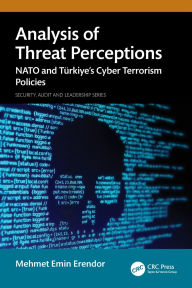PDF [Download] Analysis of Threat Perceptions:
Analysis of Threat Perceptions: NATO and Türkiye's Cyber Terrorism Policies by Mehmet Emin Erendor


- Analysis of Threat Perceptions: NATO and Türkiye's Cyber Terrorism Policies
- Mehmet Emin Erendor
- Page: 202
- Format: pdf, ePub, mobi, fb2
- ISBN: 9781040407929
- Publisher: CRC Press
English books download pdf for free Analysis of Threat Perceptions: NATO and Türkiye's Cyber Terrorism Policies in English
In 2007, Estonia faced a series of cyberattacks on its cyber infrastructure, which caused widespread damage to the country’s economy, politics, and security. However, despite this series of cyberattacks, the North Atlantic Treaty Organization (NATO) did not apply Article 5 of the North Atlantic Treaty due to lack of consensus on applying Article 5 in the Estonian case. Although various approaches have been developed by scholars, there is no common application of international law in the United Nations Charter regarding cyber threats or attacks. Moreover, while there has been no common definition of "cyber terrorism" by the international community, some scholars regard "cyberattacks" as acts of war. There is a paucity of literature dealing with the application of international law on cyber threats. A new Strategic Concept was adopted in 2010. Its most important development was to identify the significance of cyber threats to all NATO member bodies. When updating its own technology, the organization needs to be ready to defend itself against all kinds of asymmetrical warfare, whether from within or beyond its operational range. However, the terms of Article 5 of the North Atlantic Treaty were imprecise as to whether cyberattacks can be regarded as a form of threat; for this reason, NATO accepted the case‑by‑case concept on cyber threats/attacks in terms of the application of Article 5 by the Wales Summit in 2014. Despite the fact that the Charter of the United Nations has not been revised, if its articles are broadly evaluated, cyberattacks would be accepted as a threat or use of force against the territorial integrity of a state. The main purpose of this book is to analyze and evaluate what has been carried out regarding NATO’s operational arrangements and its cyber defense approach and, secondly, to explain this through the lens of Game Theory. Furthermore, it will demonstrate why the web is paramount to NATO’s system‑driven operations, and why it requires a cyber defense arrangement. In particular, the research presented here will analyze Türkiye in this regard. The cyberattack on Estonia in 2007 will be used by way of a case study to explain the development of threat perceptions, risks, international law, cybersecurity policies and application of Game Theory.
Analysis Of Threat Perceptions: Nato And Türkiye's Cyber Terrorism .
Buy the book Analysis of Threat Perceptions: NATO and Türkiye's Cyber Terrorism Policies by mehmet emin erendor at Indigo.
Reports - Cyber Defence - NATO Library
An analysis of threat perceptions: Combating cyber terrorism: The policies of NATO and Turkey, evaluated using game theory in the context of international law.
Analysis of Threat Perceptions: NATO and Türkiye's Cyber Terrorism .
Moreover, whilst there has been no common definition of 'cyber terrorism' by the international community, some scholars regard 'cyber-attacks' as acts of war.
[PDF] 12. Turkiye - The International Institute for Strategic Studies
Turkiye has been the target of several large-scale cyber attacks over the last decade. 'cyber incidents response, cyber threat analysis, and cyber crisis .
[PDF] HYBRID WARFARE, DISINFORMATION, AND THE NATO RESPONSE
These attacks were anticipated by some of the victims. SVT had been expecting an attack after receiving threats from the hacker group `Anonymous. Sudan' after .
[PDF] THE CRISIS AND THE FUTURE OF NATO - SETA
In the document, terrorism comes right after Russia, as the top threat. Then, from long- range missiles to cyber-attacks, from Syria to. Iran .
Analysis of Threat Perceptions: NATO and Türkiye's Cyber. - biblio nz
Find the best prices on Analysis of Threat Perceptions: NATO and Türkiye's Cyber Terrorism Policies by Mehmet Emin Erendor at BIBLIO NZ .
Analysis of Threat Perceptions: NATO and Türkiye's Cyber Terrorism .
Analysis of Threat Perceptions: NATO and Türkiye's Cyber Terrorism Policies . In 2007, Estonia faced a series of cyberattacks on its cyber infrastructure, which .
Analysis of Threat Perceptions: NATO and Türkiye's Cyber Terrorism .
The main purpose of this book is to analyze and evaluate what has been carried out regarding NATO's operational arrangements and its cyber defense approach and, .
Analysis of Threat Perceptions - Tomlinson-Online
NATO and Türkiye's Cyber Terrorism Policies. By (author) Mehmet Emin Erendor . cyber threats or attacks. Moreover, while there has been no common .
Analysis of Threat Perceptions NATO and Türkiye's Cyber Terrorism .
threat; for this reason, NATO accepted the case?by?case concept on cyber threats/attacks in terms of the application of Article 5 by the Wales Summit in 2014.
[PDF] NATO Cyber Defence, 2000-2022 - Scholarship@Western
The emergence of more devastating and organized cyber attacks by non-attributable threat actors internationally raises questions about .
[PDF] University of Southampton Research Repository ePrints Soton
AN ANALYSIS OF THREAT PERCEPTIONS: COMBATING CYBER TERRORISM: THE POLICIES OF NATO AND TURKEY, EVALUATED USING GAME THEORY IN. THE CONTEXT OF INTERNATIONAL .
[PDF] GEOPOLITICAL IMPLICATIONS OF CYBERSPACE ON .
The field of traditional international law faces challenges in effectively addressing cyber threats and attacks, making it difficult to establish order.
[PDF] NATO SPS Programme • Annual Report 2021
Cyber threats and attacks are becoming more frequent, sophisticated and . African Centre for Study and Research on Terrorism, representatives of the .
Links: pdf , pdf , pdf , pdf , pdf , pdf , pdf , pdf , pdf .
0コメント